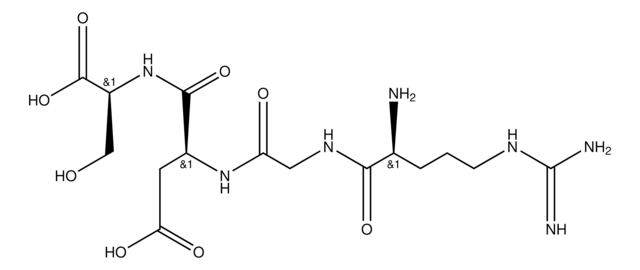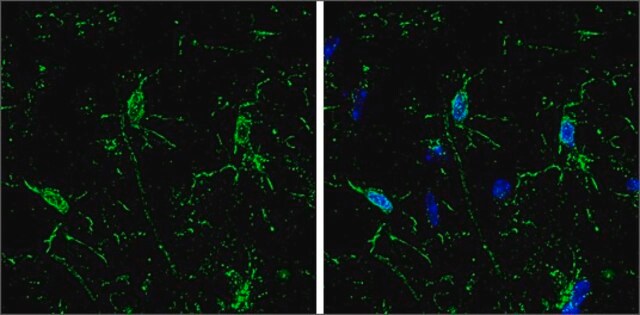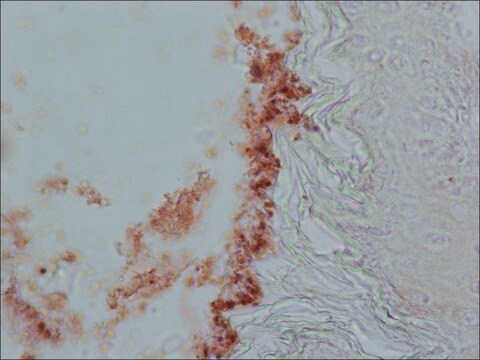14-856
Ubiquitin C-terminal hydrolase L3 (UCH-L3), 50 µg
From human cDNA, expressed in E. coli. Ubiquitin C-terminal hydrolases are a family of cysteine hydrolases that catalyze the hydrolysis of amides, esters & thioesters of the C-terminus of ubiquitin.
Autenticatiper visualizzare i prezzi riservati alla tua organizzazione & contrattuali
About This Item
Codice UNSPSC:
12352200
eCl@ss:
32160405
NACRES:
NA.32
Prodotti consigliati
Origine biologica
human
Livello qualitativo
Ricombinante
expressed in E. coli
Attività specifica
>1000 pmol/min-μg, 25 °C (with 1 μM ubiquitin-AMC as substrate and UCH-L3 at 20 pM (0.58 ng/mL).)
PM
Mw 26.2 kDa
Produttore/marchio commerciale
Upstate®
N° accesso NCBI
N° accesso UniProt
Condizioni di spedizione
dry ice
Descrizione generale
Produced from human cDNA, expressed in E. coli. Ubiquitin C-terminal hydrolases (UCHs) are a family of cysteine hydrolases that catalyze the hydrolysis of amides, esters and thioesters of the C-terminus of ubiquitin. UCH-L3 is a member of the lower molecular weight group of UCHs involved in the hydrolysis of small C-terminal derivatives of ubiquitin that form non-specifically during the process of protein ubiquitinylation.
Product Source: Recombinant human UCH-L3 expressed in E.coli.
Applicazioni
From human cDNA, expressed in E. coli. Ubiquitin C-terminal hydrolases are a family of cysteine hydrolases that catalyze the hydrolysis of amides, esters & thioesters of the C-terminus of ubiquitin.
Stoccaggio e stabilità
Store at -70°C for up to 12 months from date of receipt. As supplied, the enzyme is stable on ice for several hours. Activity is stable up to 6 freeze/thaw cycles (snap freezing in a dry/ice ethanol bath or liquid nitrogen).
Note legali
UPSTATE is a registered trademark of Merck KGaA, Darmstadt, Germany
Esclusione di responsabilità
Unless otherwise stated in our catalog or other company documentation accompanying the product(s), our products are intended for research use only and are not to be used for any other purpose, which includes but is not limited to, unauthorized commercial uses, in vitro diagnostic uses, ex vivo or in vivo therapeutic uses or any type of consumption or application to humans or animals.
Codice della classe di stoccaggio
12 - Non Combustible Liquids
Classe di pericolosità dell'acqua (WGK)
WGK 1
Punto d’infiammabilità (°F)
Not applicable
Punto d’infiammabilità (°C)
Not applicable
Certificati d'analisi (COA)
Cerca il Certificati d'analisi (COA) digitando il numero di lotto/batch corrispondente. I numeri di lotto o di batch sono stampati sull'etichetta dei prodotti dopo la parola ‘Lotto’ o ‘Batch’.
Possiedi già questo prodotto?
I documenti relativi ai prodotti acquistati recentemente sono disponibili nell’Archivio dei documenti.
K D Wilkinson et al.
Journal of molecular biology, 291(5), 1067-1077 (1999-10-16)
The ubiquitin fold is a versatile and widely used targeting signal that is added post-translationally to a variety of proteins. Covalent attachment of one or more ubiquitin domains results in localization of the target protein to the proteasome, the nucleus
Shahram Misaghi et al.
The Journal of biological chemistry, 280(2), 1512-1520 (2004-11-09)
Ubiquitin C-terminal hydrolases (UCHs) comprise a family of small ubiquitin-specific proteases of uncertain function. Although no cellular substrates have been identified for UCHs, their highly tissue-specific expression patterns and the association of UCH-L1 mutations with human disease strongly suggest a
Roles of ubiquitinylation in proteolysis and cellular regulation
Wilkinson, K D
Annual Review of Nutrition, 15, 161-189 (1995)
L J Kurihara et al.
Molecular and cellular biology, 20(7), 2498-2504 (2000-03-14)
Mice homozygous for the s(1Acrg) deletion at the Ednrb locus arrest at embryonic day 8.5. To determine the molecular basis of this defect, we initiated positional cloning of the s(1Acrg) minimal region. The mouse Uch-L3 (ubiquitin C-terminal hydrolase L3) gene
Kinetic and mechanistic studies on the hydrolysis of ubiquitin C-terminal 7-amido-4-methylcoumarin by deubiquitinating enzymes.
Dang, L C, et al.
Biochemistry, 37, 1868-1879 (1998)
Il team dei nostri ricercatori vanta grande esperienza in tutte le aree della ricerca quali Life Science, scienza dei materiali, sintesi chimica, cromatografia, discipline analitiche, ecc..
Contatta l'Assistenza Tecnica.






